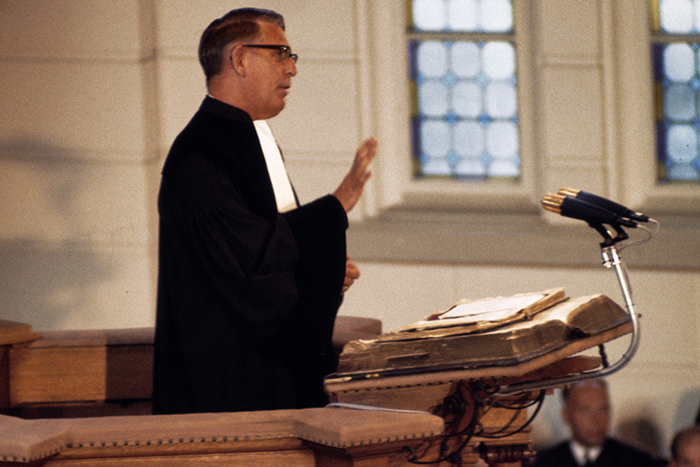(前編を読む)
説教壇にいったい何が起こったのか
[toggle]Whatever happened to the pulpit? [/toggle]説教の方法に目を向けてみよう。多くの説教者は、説教壇を必要とせず(あったとしても、透明な原稿台が置かれるだけ)、舞台上を縦横無尽に歩き回りながら説教をする。説教には30〜45分、礼拝時間の半分から、多い時には75%ほどの時間が費やされる。これによって明らかにされるのは、「礼拝堂の中で最も重要なのは説教者」ということだ。礼拝の時間の大部分、聴衆の目は説教者に向いている。
[toggle]Take the method of delivery—often without a pulpit (at best, a transparent lectern), and often by walking back and forth across the stage while preaching. And doing so for 30 to 45 minutes, at least half if not up to 75 percent of the worship hour. What all this communicates is this: The preacher is by far and away the most important person in the room. The preacher is the person upon whom we are riveted for the greater part of the service. [/toggle]私は、説教者として招かれた教会で、あるコメントを聞くまで、伝統的な説教壇が神学的にどれほど重要かに気づいていなかった。その教会の牧師たちは、舞台の中央に立って歩き回りながら説教をするのを好んだ。スタンダップ・コメディー・スタイルだ。しかし、私は急ごしらえの説教壇、小さな台の上に置かれた木製の教卓の後ろから説教をした。おもには実用的な理由からだ。私はメモや原稿にかなり依存するし、そこから横道に逸れることもない。
[toggle]I didn’t realize how theologically important the traditional pulpit was until I received a comment after one guest sermon I preached. The church’s pastoral team liked to preach from the center of the stage and wander back and forth during the sermon—the standup comic style. I, however, stood behind the makeshift pulpit—a wooden lectern sitting on a small table. I did so mainly for practical reasons—I’m pretty dependent on notes and/or a manuscript, and I didn’t wander from them. [/toggle]説教の後、ある男性が、「説教壇から説教してくださってありがとうございます」と声をかけてくれた。私がその理由を尋ねると、彼はこう説明した。「説教者の権威が、説教者と彼の人格から来ていないことを、説教壇は私たちに思い起こさせます。説教壇こそ、説教の権威が教会から来ていることのシンボルであり、同様に教会の権威が聖書から来ていることのシンボルなのです」
[toggle]After the sermon, one man said to me: “Thanks for preaching from the pulpit.” When I asked why, he explained, “The pulpit reminds us that the authority of the preacher comes not from the preacher and his personality. The pulpit is a symbol that the sermon derives its authority from the church, which in turn derives its authority from Scripture.” [/toggle]それから数週間、私はそのコメントに思いを巡らせながら過ごした。そして、説教壇の意味について思い至ったのだ。説教壇なしの説教、特にスタンダップ・コメディー・スタイルの説教では、説教で語られる言葉ではなく、人々を楽しませること、そして説教者自身にフォーカスが当てられることを。
[toggle]Pondering his comments for weeks afterward, I realized how much a pulpitless sermon, and especially the sermon delivered in standup comic style, does an extraordinarily good job of entertaining people and making the preacher, and not the preached word, the center of attention. [/toggle]
(写真:Ron Kroon)
教会へ行く途中で起こった、ある面白い事件
[toggle]A funny thing happened to me on the way to church[/toggle]ここで説教内容についても考えてみたい。誤解しないでほしいのだが、多くの福音派教会は確かにイエスについて宣べ伝えている。しかし、それが最優先になっているとは限らない。
[toggle]Add to that the problem of content. Make no mistake: Jesus is preached in many evangelical churches still. But not necessarily foremost. [/toggle]私たち福音派のクリスチャンは、イエスのためにどう生きるかという実践的な説教を鵜呑みにする。しかし、実践的であることはしばしば、聖書的であることをないがしろにしてしまうのだ。
「良い結婚生活を続けるための5つの方法」などと銘打った説教があったとしたら、そこにはところどころイエス・キリストや聖書への言及があるかもしれない。しかし、その部分を抜いたとしても、その説教の本質は変わらない。それは心理学を用いた、素晴らしく役に立つ人間関係のアドバイスなのだ。
同じように、自分の資金管理の方法についての説教を聞くこともあるだろう。それは、お金に関する本から導かれた、示唆に富む洞察からのメッセージで、箴言(しんげん)によって彩られている。子どもの育て方、キャリアの考え方、中絶反対運動への取り組みなどについての説教もある。そのような説教は、健全で賢明なアドバイスに満ちているし、私たちは多くのテーマについて、そのようなアドバイスを必要としている。
[toggle]We evangelicals are suckers for the practical sermon that tells us how to live for Jesus. But too often, the practical crowds out the biblical. A sermon on “Five Ways to Keep Your Marriage Strong” might mention Jesus or the Bible here and there, but take away those references and the substance of the sermon remains the same: great, practical relational psychology. In a similar vein, we hear sermons on how to manage one’s finances, with the key insights drawn from financial self-help literature, decorated with verses from Proverbs. And then there are the sermons on raising children and finding a career and work against abortion so on and so forth. Such sermons are full of sound and wise advice, and we need sound and wise advice on many topics. [/toggle]問題は、「それは、私たちが礼拝の中で伝えるべき最も重要なことだろうか」ということだ。週に一度、主イエス・キリストの父である神を賛美するために集うとき、はたしてこれが私たちの話すべき最も重要なことだろうか。私たちは、神の言葉に秘められた財宝と奇跡を使い果たしてしまったのだろうか。救いの栄光について、言葉を尽くして語り終えたのだろうか。それとも私たちは、神について話し飽きて、自分たちのことや、生活をより良くするための話に戻ってしまっているのだろうか。
[toggle]The question is: Is this the most vital, relevant thing we have to communicate in worship? The one time in the week in which we gather to praise and glorify the God and Father of our Lord Jesus Christ, is this really the most important thing we can say? Have we exhausted the treasures and wonders of God’s Word? Have we said all we can say about the glories of salvation? Or are we bored with talk about God, so that we revert once again to talk about ourselves and how to make our lives more manageable? [/toggle]説教で人間的な出来事が語られることを私たちが好んでいることは、「現代の説教者がどれだけ個人的なエピソードを使うか」から見ることができる。
[toggle]One giveaway that we are deeply tempted by the horizontal in preaching is the number of illustrations preachers today use from their own lives. [/toggle]以前は、説教の中で自らの生活の話をすることが良しとされない時があった。しかし、1960年代からそれは変化していった。そこで重要とされたのは、説教者も他の人と同じように、難しい状況や困難、そして誘惑に直面していることを聴衆に見せることだった。やがて聴衆は喜んで話を聞くようになり、説教者との心情的なつながりを感じることができるようになった。
[toggle]There was a time when preachers were discouraged from using their own lives as sermon illustrations. But sometime starting in the 1960s that began to change. The idea was to show listeners that the preacher was no different from the listeners and faced the same challenges, difficulties, and temptations as everyone else. This led to more attentive and appreciative listeners, who now felt they could connect psychologically with their preacher. [/toggle]現代の説教において、話の始まりや終わり、あるいは中心的命題に関連して、牧師が自分や家族の経験を話すことは珍しくなくなった。そういった説教スタイルは、聞き手が牧師に共感しやすくなるという素晴らしい効果をもたらす。そして、牧師はそれをやめることができない。礼拝のあと、人々と握手をするとき、彼らは言うのだ。「牧師の家族エピソードを聞くのが大好きです」、「お子さん、とっても可愛いですね」、「牧師の気持ち、よく分かりますよ」と。
[toggle]Today, it’s not uncommon to hear a sermon in which the opening, closing, and key illustration from the sermon’s main point is taken from the life and experience of the pastor and his family. Such sermons do a wonderful job of helping listeners connect with the pastor. And pastors keep using them precisely because when people leave the service and shake their hand, they say what a wonderful sermon it was, with comments like, “I love hearing about your family” and “Your kids are so cute” and “I really identify with you.” [/toggle]でも、考えてほしい。私たちが求めているのは、会衆が私たちの気持ちを理解することなのか。これが個人的なエピソードが持つ問題だ。このやり方では、説教者にスポットライトが当てられてしまう。数カ月そのような説教を続ければ、牧師家族の癖や、牧師の人生の成功談や失敗談、好き嫌いなどは会衆に広く知られることになる。結局、彼らはイエスについてよりも、牧師について知っていることのほうが多くなるのだ。
[toggle]Really? We want our congregations to identify with us? This is precisely the problem with personal illustrations: It inadvertently puts the spotlight on the preacher. Within a few months of such preaching, everyone knows the quirks of each member of the pastor’s family, his triumphs and failures in key parts of his life, his passions and his dislikes, and so forth. In the end, they know more about their pastor than they know about Jesus. [/toggle]牧師たちの中には、キリストの呼びかけに応えられなかった自らの弱さについて話すことで、この方法を擁護する者もいる。その牧師は、それによって会衆がさらに牧師を仰ぎ見ることになってしまうことを理解していない。そういった例話は常に、説教者が自分の欠陥を認識したり、悔い改めたりした瞬間の話だ。そうやって牧師は謙虚さの模範となる! たとえ「まだ苦労している最中ですが」と付け加えたところで、誰もその言葉を信じないか、霊的に実直な模範として崇(あが)めるだけだ。
[toggle]Some pastors defend the practice by saying they only use negative examples of themselves—talking about ways in which they have failed to live up to the call of Christ. What they don’t realize is that this just raises their status even higher with the congregation. Invariably, the illustrations turn on a moment or realization when the preacher recognized his flaw and changed direction. So now the pastor is someone who is a model of humility! And even if the pastor says, “I still struggle with this,” either no one really believes her or they exalt her as a model of spiritual seriousness—they think, She really is working hard on her spiritual life! [/toggle]要するに、信仰を創(つく)り、完全なものにするイエスへ注がれるべき人々の視線を奪うことなく、私生活からの例話を使う方法はほとんどない。イエスの役割は、説教者の役割の一部になってしまった。その説教者は、エピソード・トークなしに福音を人々に伝えることができない。
[toggle]There is, in short, hardly a way to use an illustration from one’s personal life without it distracting listeners’ gaze from Jesus, the author and perfecter of our faith. That role has now been subsumed by the preacher, who depends on the personal illustration to make the sermon relevant. [/toggle]あまりにも多くの福音派の牧師がそのやり方に依存している。正直に言おうではないか。彼らは信徒からの反応が嬉しいのだ。人々は礼拝のあと、大げさに握手しながら、彼らがその小話をどれだけ楽しんだかを話してくれる。私には、牧師がなぜ嬉しいのかが分かる。牧師とは孤独で不安な人々なのだ。私たちは他の人々と同じように(あるいはそれ以上に)安心を必要としている。ほかのみんなが「個人的に、親密に、もっと話してくれ」と言ってくれるような日に、その誘惑に抵抗することは非常に難しい。
[toggle]Too many evangelical pastors have become addicted to using them because, let’s face it, they love the feedback. People pump their hand after the service and tell them how much they enjoyed that little story. I know of where I speak. Pastors are a lonely and insecure lot, and we need affirmation as much as (and maybe more) than everyone else. It is very difficult to resist this temptation in a day when the personal, the intimate, and tell-all is the order of the day everywhere else. [/toggle](多くの教会ではそうではないが、そのような時間を「礼拝」として理解するのをやめたのも自然な成り行きだ。これについては、神が賛美を与えてくださったことに感謝したい。賛美は少なくとも私たちを完全に人間関係のみの目線に立つことから引き留めてくれる)。(後編に続く)
[toggle] (It is no wonder that we’ve stopped understanding this part of the service as “worship.” It isn’t in so many of our churches. In this regard, I thank God for praise choruses—they at least keep the service from completely collapsing into the horizontal.) [/toggle]